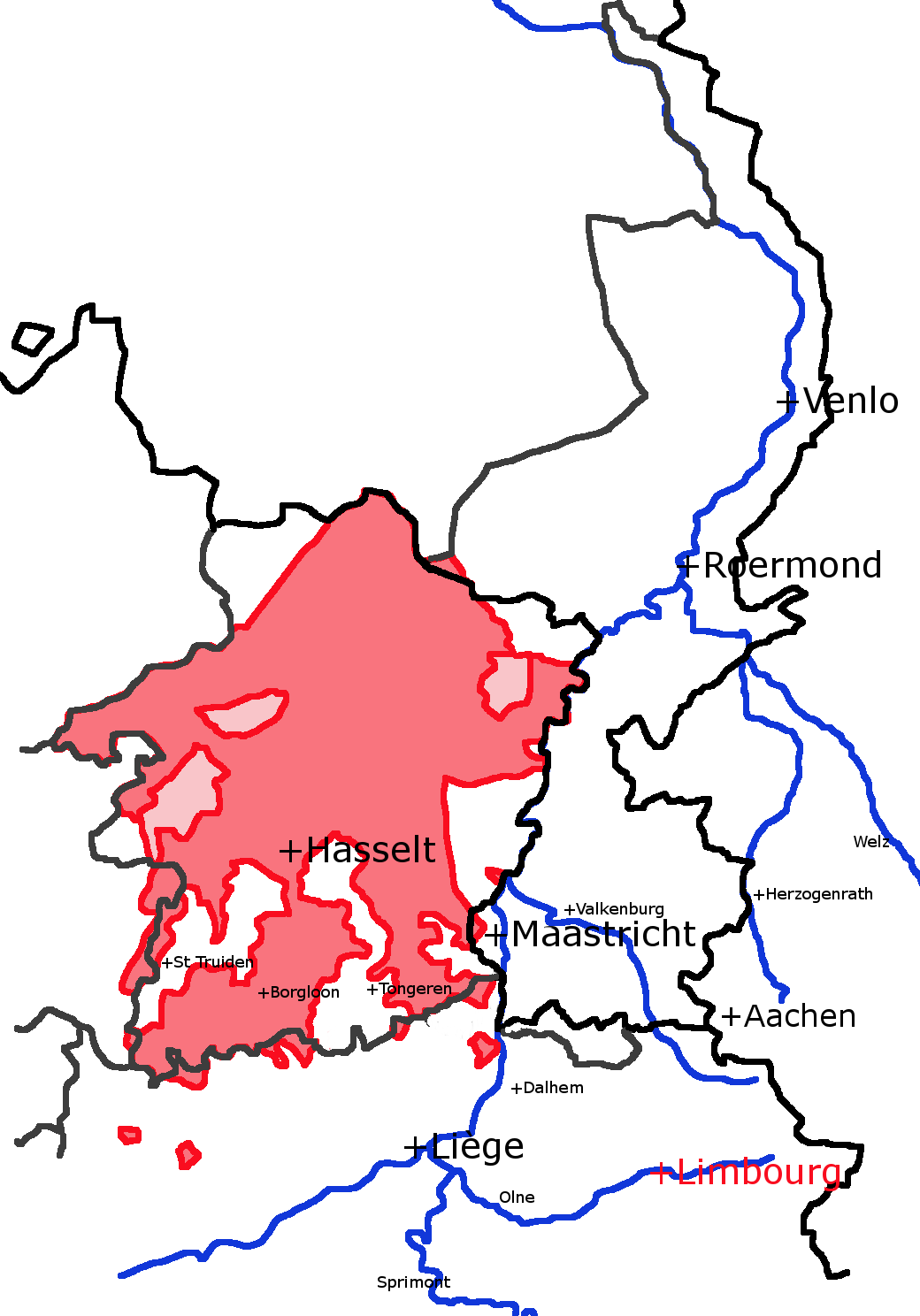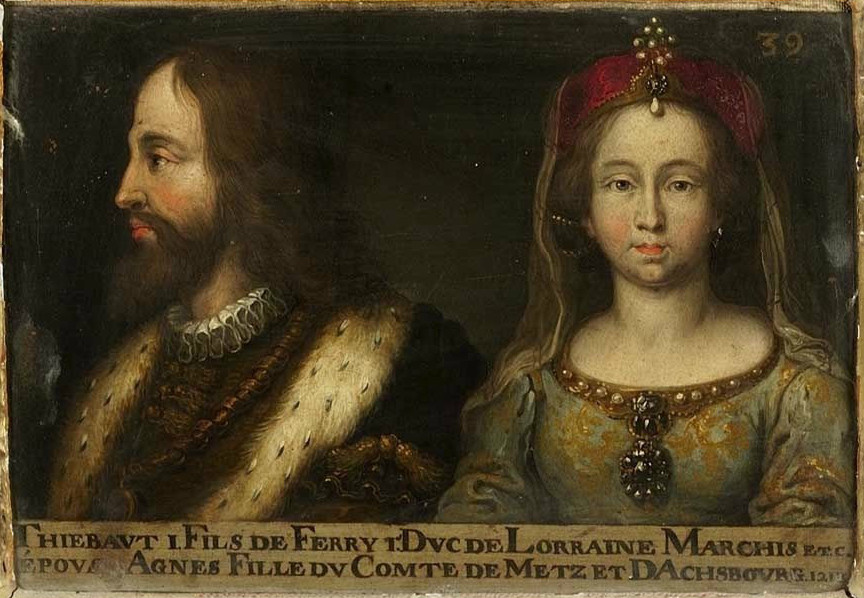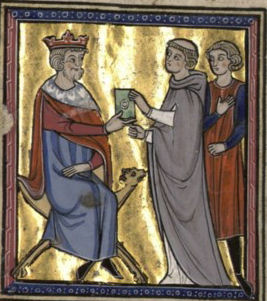|
Arnold I, Count Of Loon
Arnold I (b. about 1045 - d. about 1125), Count of Loon (Looz) from about 1079, son of Emmo, Count of Loon, and Suanhildis, daughter of Dirk III, Count of Holland, and his wife Othelandis. He was an ally of Henry of Verdun and Otbert, both bishops of Liège. In 1078, he endowed the collegiate churches of Huy and of St. John at Liège. In 1088, he negotiated at the request of Bishop Henry of Verdun to end a conflict in the abbey of Sint-Truiden where the bishop and emperor Henry IV had appointed rival abbots. As a result of his diplomacy, the emperor transferred the authority of the abbey from Henry I, Duke of Lower Lorraine, to Arnold.{{cn, date=October 2021 Arnold forced Henry and his ally Godfrey of Bouillon, to withdraw from the monastery. The domain of Arnold expanded with the County of Rieneck by his marriage to Agnes of Mainz, daughter of Gerhard I, Count of Rieneck, and Helwig von Bliescastel. Sources disagree on their number of children, but they are believed to ... [...More Info...] [...Related Items...] OR: [Wikipedia] [Google] [Baidu] |
County Of Loon
The County of Loon ( , , ) was a county in the Holy Roman Empire, which corresponded approximately with the Belgian province of Limburg. It was named after the original seat of its count, Loon, which is today called Borgloon. During the middle ages the counts moved their court to a more central position in Kuringen, which is today a part of Hasselt, the modern capital of the region. From its beginnings, Loon was associated with the Prince-bishop of Liège and by 1190 the count had come under the bishop's overlordship. In the fourteenth century the male line ended for a second time, at which point the prince-bishops themselves took over the county directly. Loon approximately represented the Dutch-speaking (archaic ) part of the princedom. All of the Dutch-speaking towns in the Prince-Bishopric, with the status of being so-called "Good Cities" (french: bonnes villes), were in Loon, and are in Belgian Limburg today. These were Beringen, Bilzen, Borgloon, Bree, Hamont, Hassel ... [...More Info...] [...Related Items...] OR: [Wikipedia] [Google] [Baidu] |
Berengar II Of Sulzbach
Count Berengar II of Sulzbach (c. 1080–83 – 3 December 1125), sometimes known as Berengar I of Sulzbach, was Count of Sulzbach in Bavaria. Berengar was a leader of the reform party. He sided with Pope Gregory VII during the Investiture Controversy in opposition to Henry IV, Holy Roman Emperor, and supported Henry V in his successful rebellion against his father. He is known as the founder of several abbeys. Family Berengar's grandfather was Gebhard I, Count of Sulzbach (died 1071), who married the daughter of Count Berengar I of Sulzbach. Gebhard I may have been the son of Herman IV, Duke of Swabia, but this is not certain. Gebhard I may have been the father of Gebhard II. Berengar was the son of Count Gebhard II of Sulzbach (died 1085) and Irmgard of Rott (died 14 June 1101). His sister Adelaide may have married Count Siboto II of Weyarn-Falkenstein, who was later the advocate of Baumburg Abbey. The Weyarns at first supported Henry IV in his conflict with Pope Gregory VII ... [...More Info...] [...Related Items...] OR: [Wikipedia] [Google] [Baidu] |
Biographie Nationale De Belgique
The ''Biographie nationale de Belgique'' ( French; "National Biography of Belgium") is a biographical dictionary of Belgium. It was published by the Royal Academy of Belgium in 44 volumes between 1866 and 1986. A continuation series, entitled the ''Nouvelle Biographie Nationale'' ("New National Biography"), has been published by the Royal Academy of Science, Letters and Fine Arts of Belgium since 1988. Both the ''Biographie nationale'' and ''Nouvelle biographie nationale'' were digitised by the Fonds InBev-Baillet Latour and can be freely consulted at the Academy's website. A parallel biographical dictionary has been produced in Dutch since 1964, entitled the ''Nationaal Biografisch Woordenboek'' ("National Biographical Dictionary"). It places more emphasis on figures important to the history and culture of Flanders and is published by the Royal Flemish Academy of Belgium for Science and the Arts (with the co-operation of the Royal Academy of Dutch language and literature and the R ... [...More Info...] [...Related Items...] OR: [Wikipedia] [Google] [Baidu] |
Gérard I, Count Of Looz
Count Gerard (or Gerhard) of Loon (died 1191), was son and successor of Louis I, Count of Loon, and Agnes of Metz. He was count of Loon (in modern Belgium) and of Rieneck (in Germany). Because of a widespread misunderstanding concerning a document from 1101, some generations earlier, he is sometimes wrongly referred to as the second Gerard in this dynasty, "Gerard II". Biography Gerard became count in difficult times. His father Louis, who ravaged the territory of Sint-Truiden, was attacked and beaten near Brustem on July 28, 1171, by the citizens of Sint-Truiden and Gilles, Count of Duras. They then besieged his castle of Loon (now Borgloon), killing Count Louis on 11 August. The assault was prevented by the arrival of reinforcements form Louis’ son-in-law Godfrey III, Count of Louvain, and a truce was concluded. Gerard and his mother went to emperor Frederick Barbarossa in Aachen to obtain compensation, but the citizenry of Sint-Truiden successfully defended their claim. Fallin ... [...More Info...] [...Related Items...] OR: [Wikipedia] [Google] [Baidu] |
Arnout III, Count Of Aarschot
Arnout III (1080-after 1136), Count of Aarschot, son of Arnout II, Count of Aarschot, and his wife whose name remains unknown. Arnout is sometimes confused with his father, especially in regard to the blood shedding at Aachen in 1115. Arnout supported the founding of the Averbode Abbey in 1134, part of the Archdiocese of Mechelen-Brussels, that was made possible by donations by Arnold II, Count of Looz, the Abbey of Sint-Truiden, the lords of Aarschot and Diest, and Godfrey III, Count of Louvain. In at least two documents, Arnout was not referred to as a count. Arnout married Beatrix of Looz, daughter of Arnold I, Count of Looz and sister of his fellow benefactor of the Averbode Abbey. Arnout and Beatrix had four children: * Arnout IV, Count of Aarschot * Godfried II (d. after 1152) * John (d. after 1125), a monk at the Afflighem Abbey. It is possible that he is the renown John John is a common English name and surname: * John (given name) * John (surname) John may a ... [...More Info...] [...Related Items...] OR: [Wikipedia] [Google] [Baidu] |
Count Of Jülich
Count (feminine: countess) is a historical title of nobility in certain European countries, varying in relative status, generally of middling rank in the hierarchy of nobility. Pine, L. G. ''Titles: How the King Became His Majesty''. New York: Barnes & Noble, 1992. p. 73. . The etymologically related English term "county" denoted the territories associated with the countship. Definition The word ''count'' came into English from the French ''comte'', itself from Latin ''comes''—in its accusative ''comitem''—meaning “companion”, and later “companion of the emperor, delegate of the emperor”. The adjective form of the word is "comital". The British and Irish equivalent is an earl (whose wife is a "countess", for lack of an English term). In the late Roman Empire, the Latin title ''comes'' denoted the high rank of various courtiers and provincial officials, either military or administrative: before Anthemius became emperor in the West in 467, he was a military ''comes ... [...More Info...] [...Related Items...] OR: [Wikipedia] [Google] [Baidu] |
Theobald I Of Navarre
Theobald I (french: Thibaut, es, Teobaldo; 30 May 1201 – 8 July 1253), also called the Troubadour and the Posthumous, was Count of Champagne (as Theobald IV) from birth and King of Navarre from 1234. He initiated the Barons' Crusade, was famous as a trouvère, and was the first Frenchman to rule Navarre. Rule of Champagne Regency of Champagne Born in Troyes, he was the son of Theobald III of Champagne and Blanche of Navarre, the youngest daughter of Sancho VI of Navarre. His father died less than a week before he was born, and Blanche ruled the county as regent until Theobald turned twenty-one in 1222. He was a notable trouvère, and many of his songs have survived, including some with music. The first half of Theobald's life was plagued by a number of difficulties. His uncle, Count Henry II, had left behind a great deal of debt, which was far from paid off when Theobald's father died. Further, Theobald's right to the succession was challenged by Henry's daughter Philippa an ... [...More Info...] [...Related Items...] OR: [Wikipedia] [Google] [Baidu] |
Gertrude Of Dagsburg
Gertrude of Dagsburg (died 30 March 1225) was the reigning countess of Metz and County of Dagsburg, Dagsburg (Dabo) between 1212 and 1225. She was duchess consort of Lorraine by marriage to Theobald I, Duke of Lorraine, Theobald. She was a trouvère. She was the daughter and heiress of Albert II, count of Metz and County of Dagsburg, Dagsburg (Dabo). Life Gertrude was named after her mother, Gertrude of Baden, the daughter of Herman III, Margrave of Baden. The birth date of May 1205 (or as late as mid-1206) often assigned to her is questionable, as her mother was then 52 years old. at the Medieval Lands Project. A more plausible date is c. 1190. Gertrude succeeded her father as countess on his death in 1212, at which time she had already married Theobald I, Duke of Lorraine, Theobald, soon to be Duke of Lorraine (1213), according to the ''Vitæ Odiliæ''. Their betrothal occurred in September 1205, possibly when she was an infant. On her marriage her husband took over the admi ... [...More Info...] [...Related Items...] OR: [Wikipedia] [Google] [Baidu] |
Manuel I Comnenus
Manuel I Komnenos ( el, Μανουήλ Κομνηνός, translit=Manouíl Komnenos, translit-std=ISO; 28 November 1118 – 24 September 1180), Latinized Comnenus, also called Porphyrogennetos (; " born in the purple"), was a Byzantine emperor of the 12th century who reigned over a crucial turning point in the history of Byzantium and the Mediterranean. His reign saw the last flowering of the Komnenian restoration, during which the Byzantine Empire had seen a resurgence of its military and economic power and had enjoyed a cultural revival. Eager to restore his empire to its past glories as the superpower of the Mediterranean world, Manuel pursued an energetic and ambitious foreign policy. In the process he made alliances with Pope Adrian IV and the resurgent West. He invaded the Norman Kingdom of Sicily, although unsuccessfully, being the last Eastern Roman emperor to attempt reconquests in the western Mediterranean. The passage of the potentially dangerous Second Crusade thr ... [...More Info...] [...Related Items...] OR: [Wikipedia] [Google] [Baidu] |
Bertha Of Sulzbach
Bertha of Sulzbach (1110s – August 29, 1159) was a Byzantine Empress by marriage to Byzantine Emperor Manuel I Komnenos. Life She was born in Sulzbach, a daughter of Berengar II, Count of Sulzbach (c. 1080 – 3 December 1125) and his second spouse Adelheid of Wolfratshausen. He was one of the rulers who signed the Concordat of Worms (23 September 1122). In August, 1125, Berengar is mentioned in documents of Lothair III, King of the Romans. The death of Berengar is mentioned four months later. Empress Emissaries of the Byzantine emperor John II Komnenos arrived in Germany, seeking an alliance against Roger II of Sicily. To seal the alliance, the emissaries requested that Conrad send a princess of his family to be married to the emperor's son, Manuel. Instead, Conrad selected his sister-in-law, Bertha, and after legally adopting her as his daughter, sent her to the Byzantine Empire escorted by Emicho von Leiningen, the Bishop of Würzburg. By the time Bertha arrived at the ... [...More Info...] [...Related Items...] OR: [Wikipedia] [Google] [Baidu] |
Conrad III Of Germany
Conrad III (german: Konrad; it, Corrado; 1093 or 1094 – 15 February 1152) of the Hohenstaufen dynasty was from 1116 to 1120 Duke of Franconia, from 1127 to 1135 anti-king of his predecessor Lothair III and from 1138 until his death in 1152 king in the Holy Roman Empire. He was the son of Duke Frederick I of Swabia and Agnes, a daughter of the Salian Emperor Henry IV. His reign saw the start of the conflicts between the Guelphs and Gibbelins. He was involved in the failed Second Crusade with Louis VII, where he would fight and lose at Doryleum and would later fall ill and return to Constantinople. After recuperating, he went to Jerusalem but would experience a string of failed sieges. Later returning from the Crusade, he was entangled in some conflicts with Welf VI's claim to the Duchy of Bavaria. On his deathbed, he designated his nephew Frederick Barbarossa as his successor instead of his son, Frederick. Descent The origin of the House of Hohenstaufen in th ... [...More Info...] [...Related Items...] OR: [Wikipedia] [Google] [Baidu] |
Gertrude Von Sulzbach
Gertrude of Sulzbach (german: Gertrud; – 14 April 1146) was German queen from 1138 until her death as the second wife of the Hohenstaufen king Conrad III. Life She was the daughter of the Bavarian count Berengar II of Sulzbach (c.1080–1125) and Adelheid of Wolfratshausen (d. 1126). The identity of Gertrude's mother is mentioned in the ''Kastler Reimchronik'', Vers 525. Adelheid of Wolfratshausen is mentioned in various other documents of the 12th century as "Countess of Sulzbach", without mentioning her husband. ''De Fundatoribus Monasterii Diessenses'' contains a rather confused genealogy concerning her two most prominent daughters. Otto II, Count of Wolfratshausen, father of Adelheid, is given as father to Richenza of Northeim, "Empress" and "Maria, Empress of the Greeks". Richenza was actually the wife of Lothair II. The author of the text had apparently confused her with Gertrude von Sulzbach. Maria is probably a confusion for "Irene", the baptismal name of Gertrude's ... [...More Info...] [...Related Items...] OR: [Wikipedia] [Google] [Baidu] |






